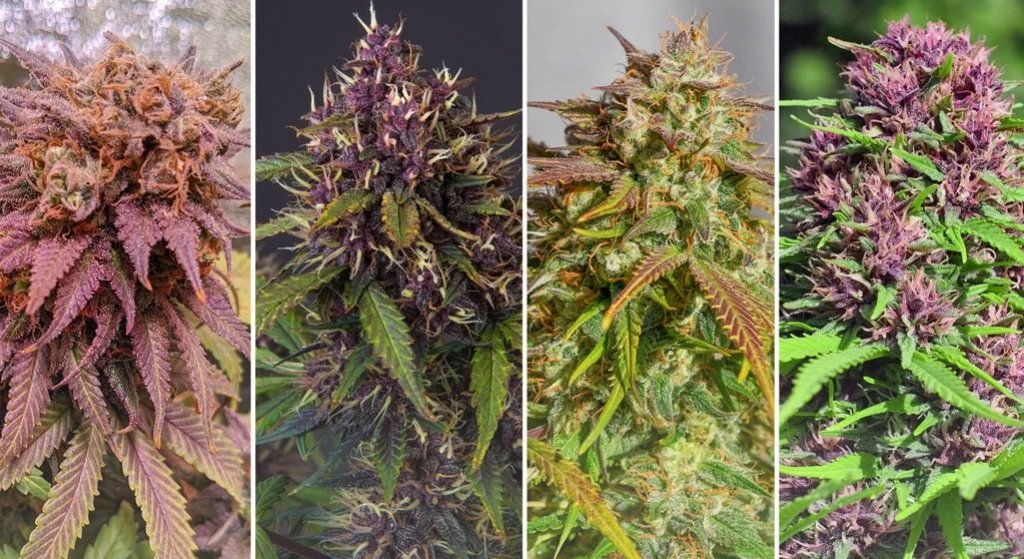Weed Colors: What Are They And What Do They Mean
Different Colors Of Weed
Green:
Pigment/Compound: Chlorophyll
Common Varieties: Green Goblin, Green Haze, Green Crack
Green is the color most commonly associated with cannabis and reflects its vigorous and adaptable nature. This predominant hue is the result of the presence of chlorophyll, the pigment responsible for photosynthesis.
Cannabis strains that maintain a deep green color often indicate healthy growth and optimal growing conditions. In addition, the green in cannabis can vary in hue, from bright green to a darker, earthy green, depending on factors such as strain genetics and stage of maturation.
In terms of effects, green strains are incredibly versatile, being able to offer anything from energetic and uplifting sensations to deep relaxation and sedation, depending on the unique chemical composition of each strain.
Violet/Purple:
Pigment/Compound: Anthocyanins
Common strains: Purple Urkle, Granddaddy Purple, Purple Haze
Purple is one of the most wanted colors in cannabis, as it evokes a sense of luxury and sophistication.
Strains exhibiting purple hues are usually Indica-dominant and are distinguished by their unique fruity aroma and flavor. This characteristic color develops in response to cooler temperatures during the flowering phase, which stimulates the production of anthocyanins.
In addition to its aesthetic appeal, purple cannabis is often associated with relaxing and sedative effects.
Red:
Pigment/Compound: Anthocyanins
Common strains: Red Dragon, Red Poison, Pink Panther
Red hairs are appearing more frequently these days, but surprisingly, red buds and leaves are not as common. In fact, the red color in cannabis is a rarity, as it is only produced by a specific genetic mutation.
It is normal for some buds to have reddish pistils, but strains that exhibit red hues are usually carefully created hybrids that combine Ruderalis, Indica, and Sativa varieties. This distinctive color is not only visually striking but can also indicate a high concentration of certain compounds, potentially resulting in powerful effects.
Medicinal users often seek out red strains because of their analgesic and anti-inflammatory properties.
You can also cheat by changing the leaves and buds of plants to red by manipulating the nutrients. Phosphorus deficiencies can cause this, but it won’t be as pretty as the real thing.
Orange:
Pigment/Compound: Carotenoids
Common Varieties: Orange Cookies, Orange Haze, Orange Dream
This vibrant color is due to the presence of carotenoids, compounds also found in fruits and vegetables such as carrots and pumpkins.
Orange hues in cannabis can indicate specific growing conditions, such as alkaline pH levels or nutritional deficiencies. Orange will primarily affect hairs and buds.
In terms of effects, strains with orange hues can offer uplifting and stimulating experiences, perfect for combating stress and improving mood. In addition, their citrus aroma and sweet and sour taste give these strains a different touch.
Yellow:
Pigment/Compound: Carotenoids
Common strains: Lemon Haze, Golden Lemon, Strawberry Banana
Carotenoids give cannabis those citrus shades of yellow, gold, and orange.
To get these colors, you need higher alkaline conditions. If these colors are predominant in the plant, they will come out naturally when the flowering phase is over and the chlorophyll starts to fade.
Yellow strains often have high THC concentrations, which can result in a euphoric and stimulating experience.
Blue:
Pigment/Compound: Anthocyanins
Common Strains: Blue Haze, Blue Cheese, Blue Dream
Cannabis strains that exhibit blue hues are prized for their exotic appearance and relaxing effects.
This characteristic color is produced by the presence of high concentrations of anthocyanins, which develop in response to cooler temperatures during the flowering phase.
The blue color in cannabis is typically indicative of predominantly Indica strains, which offer a deep and calming physical high. Consumers seeking relief from stress and muscle tension often gravitate toward blue strains for their ability to induce a sense of calm and serenity.
Black:
Some rare strains turn so dark that their bud color appears black.
The origin of these genetics can be traced back to Vietnamese landraces, such as Vietnamese Black. Other hybrid-derived strains, such as Black Willy and Black Tuna, share the characteristic dark buds and leaves.
In addition, black strains are noted for their intense, semi-psychedelic cerebral highs. If you want visual effects, this lineage is a sure hit.
The inky appearance comes from an overabundance of all colors on the leaves. With warmer temperatures, dark reds and purples are replaced by lighter reds and golds in some cases.
CLICK HERE TO CONTINUE LEARNING







